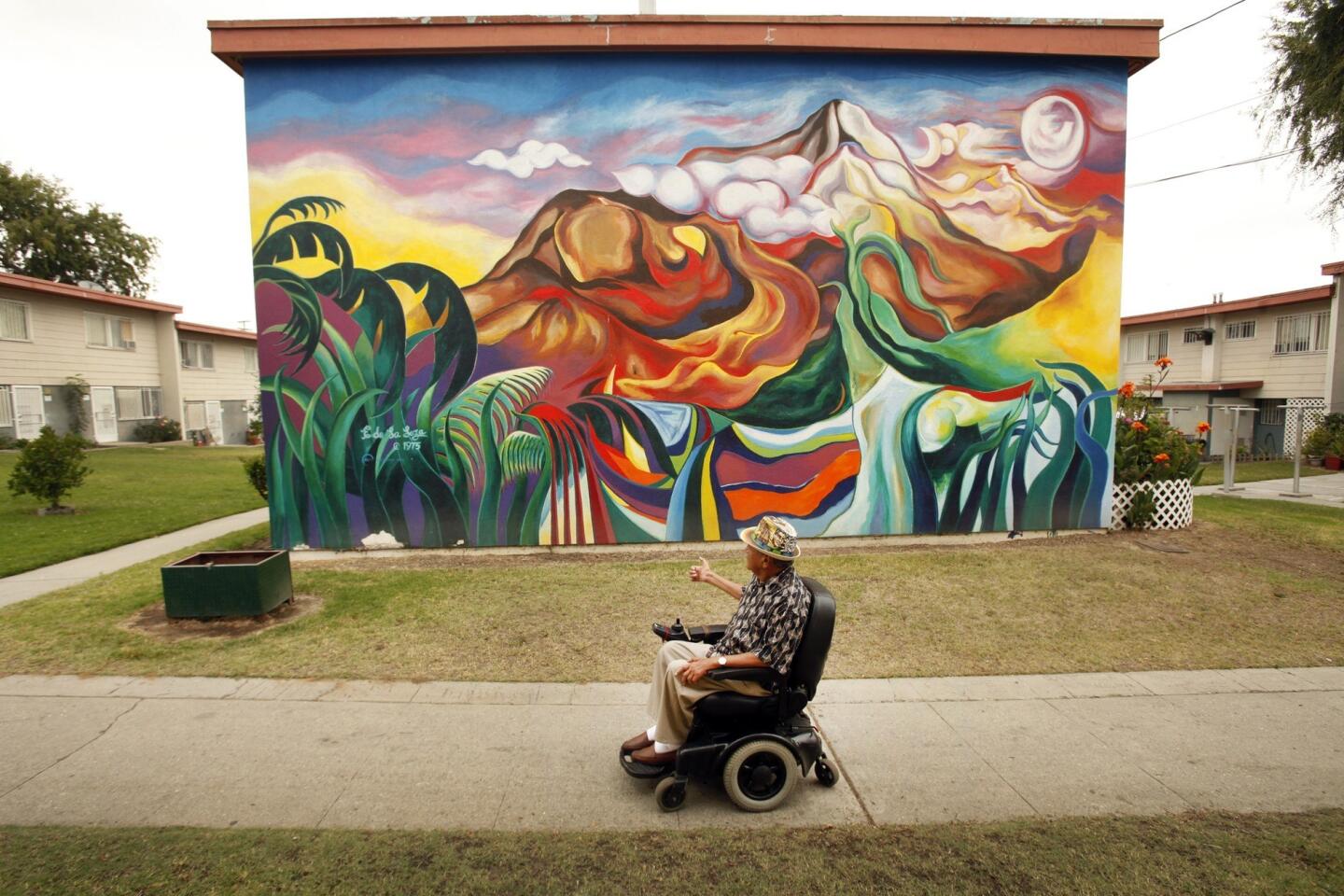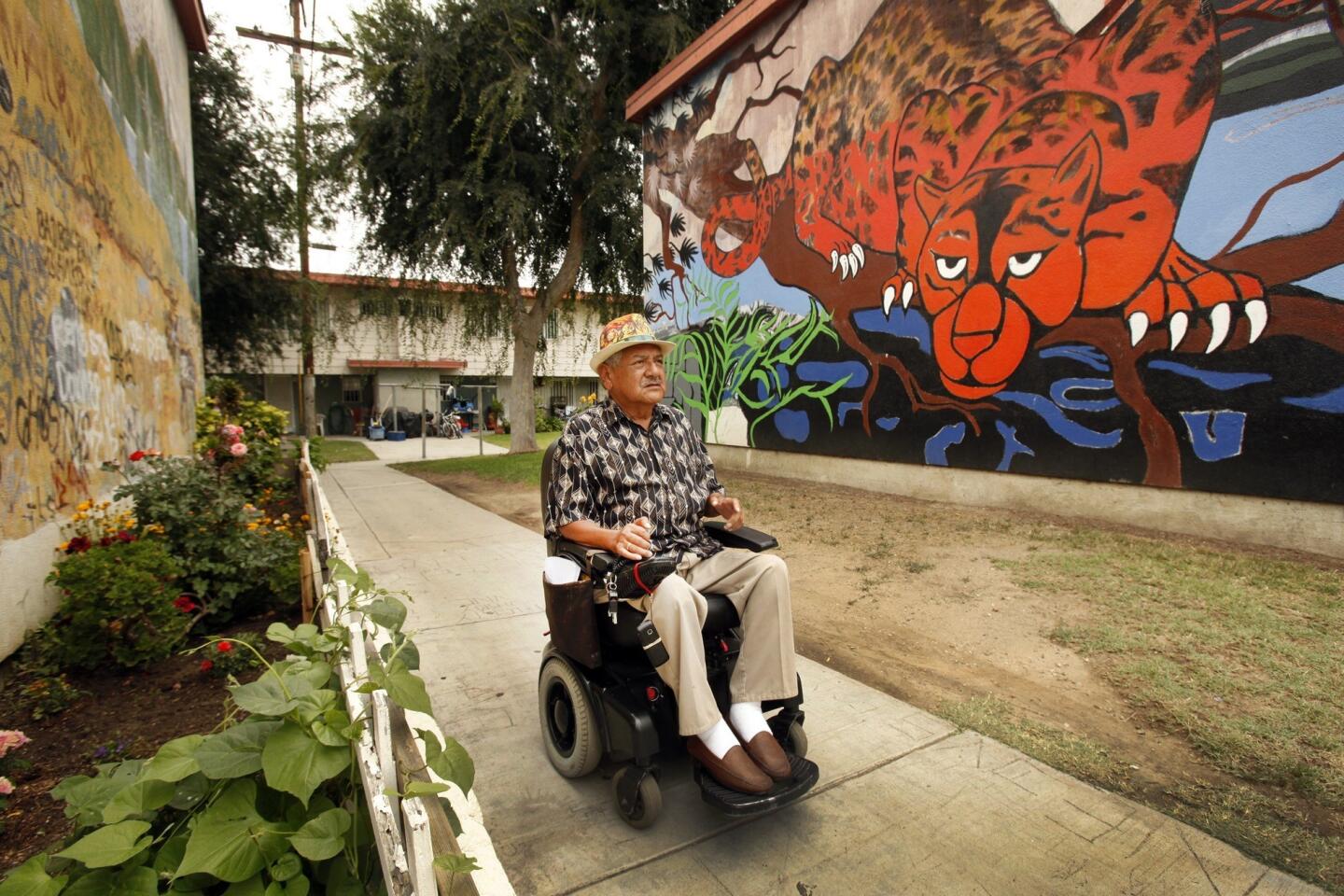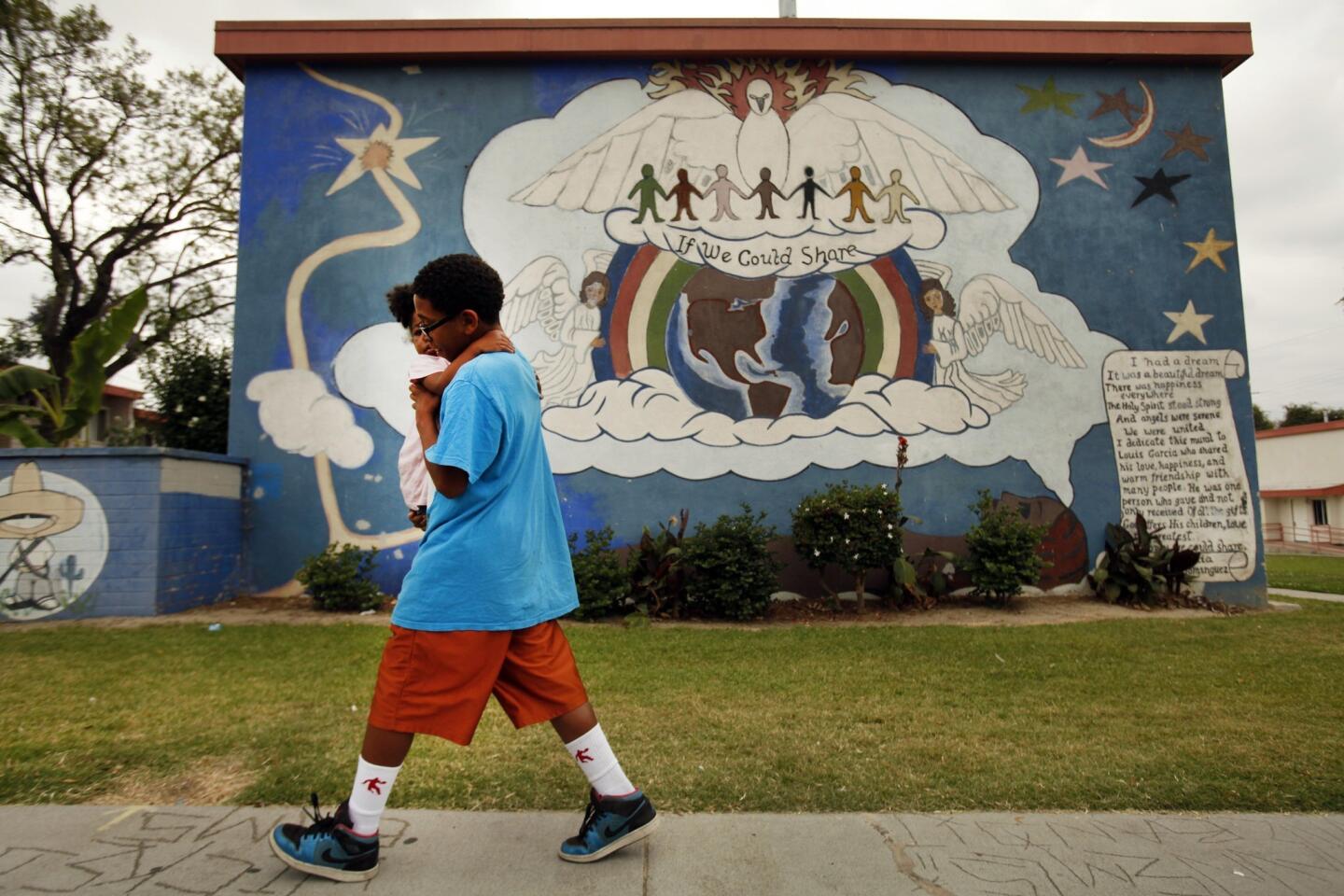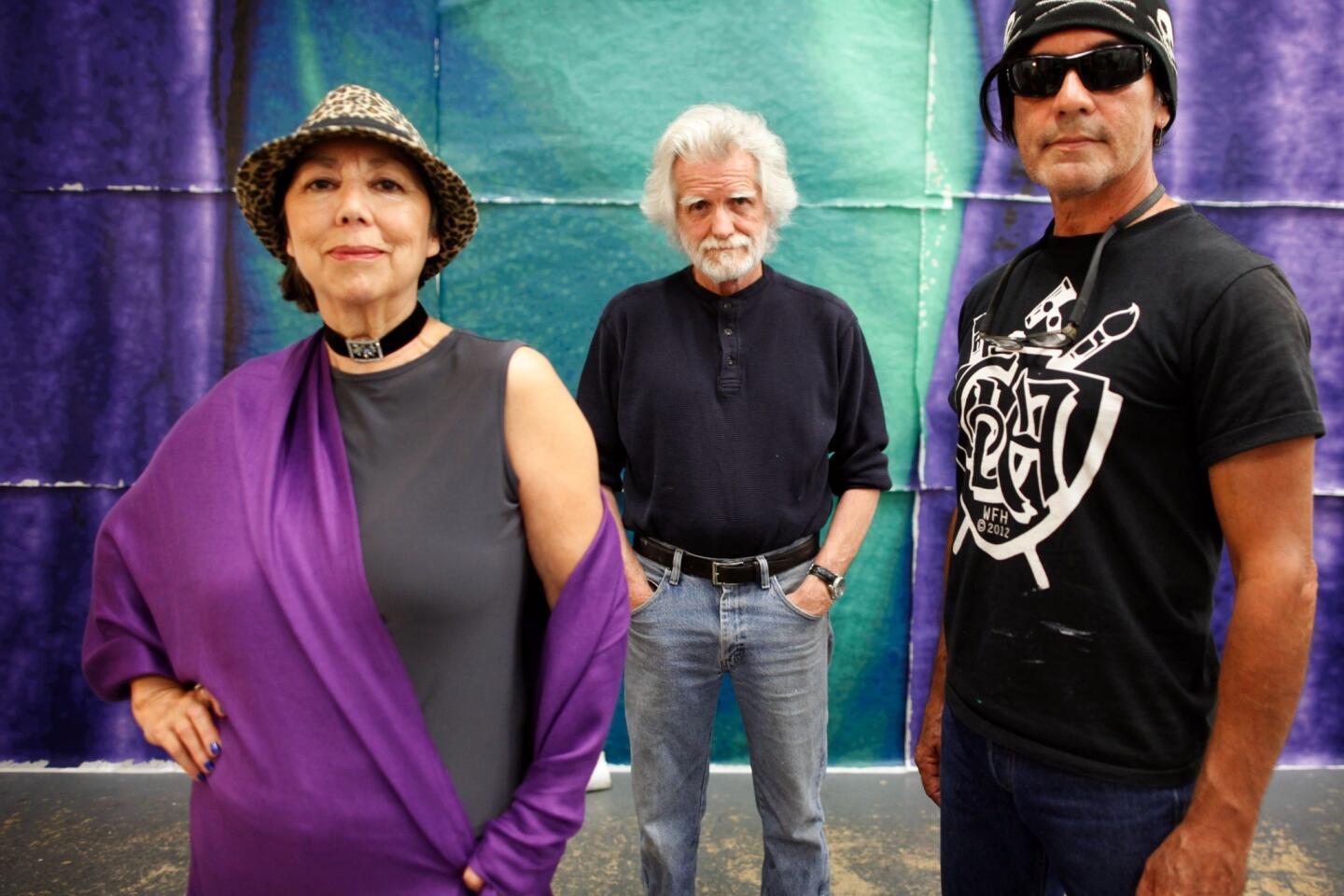Arguments over L.A.’s mural ban paint different pictures
When José Huizar was growing up in Boyle Heights in the 1970s, the profusion of murals on apartment buildings and private homes spoke to a burgeoning sense of community pride among the city’s Mexican American population.
“They had a positive impact on me, especially the one ‘We Are Not a Minority,’” said Huizar, an L.A. city councilman, referring to a well-known mural at the Estrada Courts housing complex. “It made me question and ask about my identity and what life is about in East L.A. It’s kind of empowering.”
Now, Huizar is among the main sponsors of a proposed ordinance that could lift Los Angeles’ decade-old ban on virtually all original murals on private property and launch a permitting and registration system for creating new ones. “It’s been a long time coming. Long overdue,” Huizar said during an interview last week.
PHOTOS: Murals on privately owned buildings
But as the ordinance has moved closer to a vote, it has raised concerns among some elected officials and neighborhood councils that it could lead to a slew of new murals in residential neighborhoods that don’t want them. In particular, some are troubled by a possible provision that would allow both painted and digital murals to be rendered on single-family structures, subject to a prior neighborhood approval process.
“This really could change the character and the nature of every community,” said Councilman Mitchell Englander, who represents much of the northwest San Fernando Valley. He supports parts of the proposal but is wary of including single-family (R1) structures.
Historically in Los Angeles, which styles itself as one of the world’s mural capitals, the debate over whether and what types to allow has been emotionally charged, touching on issues of politics, class and ethnicity as well as taste and aesthetics.
Judy Baca, a muralist and founder of the Social and Public Art Resource Center, said that underlying the language of the measure is a “tremendous amount of back-and-forth” and “a great deal of struggle between various interests.”
“Do we allow our city to become a kind of place of visual blight, like a Hong Kong kind of visualization of ads in every inch of eyespace?” Baca said. “Or are there places in which.... public art can have its diverse expression?”
The draft ordinance would allow for the creation and preservation of original art murals and “public art installations,” but not “commercial messages” on private property. Proponents had hoped to vote on the measure before seven current council members leave office at the end of the month, but that now appears unlikely. Backers hope to bring the proposal to a vote by the end of July.
PHOTOS: Arts and culture in pictures by The Times
Several of the city’s leading muralists, including Kent Twitchell and Willie Herrón III, have voiced support for the effort, even if it initially does not include R1 structures.
Herrón, a founding member of the Chicano artists collective Asco, dismisses contentions made by some that the ordinance could produce a rash of Chicano iconography across the city. One opponent, in an open letter to Councilman Bill Rosendahl, asserted that allowing more murals would “encourage graffiti” and “glorify gangbangers.”
“What makes them think that all of a sudden there’s going to be millions of Che Guevara’s and Zapatas in their neighborhood?” Herrón said. “To me it just comes off racist.”
If a new ordinance isn’t enacted, and existing murals aren’t protected under a grandfather clause, Twitchell said, not only will murals in blue-collar neighborhoods be threatened — so will the kind of faux-finish artwork and trompe l’oeil frescoes favored by wealthy owners of gated mansions. Singer Chris Brown is currently fighting to preserve a mural depicting 8-foot-tall monsters at his Hollywood Hills home, over neighbors’ objections.
“They’re going to mess around with some really rich and powerful people if they tell them they can’t paint frescoes on the front of their houses,” Twitchell said.
The path to lifting the city’s mural ban has been long and bumpy. That’s partly because the new ordinance is intended to correct what is widely regarded as a major blunder: the city’s attempt to protect mural art by defining and treating it separately from graffiti and commercial signage.
Eventually, that resulted in commercial sign companies suing the city and the city enacting a comprehensive ban on private-property murals in 2003. For years, the dispute was tied up in litigation. “Chalk it up to a huge, faux pas, policy-wonk mistake,” said Debra Padilla, executive director of SPARC, which supports the new ordinance.
CRITICS PICKS: What to see, hear, taste and more this weekend
The new proposal began to take shape around 2010, as the litigation finally was settled. That opened a “pathway,” Huizar said, for the city “to start focusing on how do we allow murals to go up again.”
The mural ban has been patchily enforced by the city, and murals have continued to go up on private property. But many have been destroyed. In some cases, property owners, fearing citations, have painted over the artworks themselves.
Baca estimates that half the city’s art murals were lost during the decade-long ban. “We’ve created this, not only incredibly unfriendly, but anti-mural sentiment. And in that process we lost some really important and major works,” Baca said.
Isabel Rojas-Williams, an art historian and executive director of the Mural Conservancy of Los Angeles, said that other cities, such as Portland, Ore., and Philadelphia, have encouraged new murals in recent years.
But Los Angeles, she said, has had a love-hate relationship with murals ever since the 1930s, when the city allowed the “America Tropical” mural in downtown Los Angeles, by the Mexican master painter David Alfaro Siqueiro, to be whitewashed because of its provocative image of a Mexican Indian being lashed to a cross presided over by an eagle symbolizing the United States. The work finally was restored and unveiled last fall in a new interpretive center.
“That mural is as current today as it was then,” Rojas-Williams said. “It was speaking about the same issues that we’re speaking right now: social justice, empowerment, education.”
It’s still unclear whether the final form of the ordinance will include the R1 provision, as well as language that would allow about 300 existing art murals to be protected under a grandfather clause. Both provisions are favored by ordinance proponents.
A number of other regulatory issues are still being reviewed by councilmembers and the city attorney. Among those listed in drafts obtained by The Times is a requirement for new murals to first pass through a neighborhood review process, and to be registered through an application process with the Department of Cultural Affairs, along with the payment of a fee based on the project’s total valuation.
New murals would be required to remain in place without alteration for a minimum of two years. But they could be “de-registered” and removed if the property is sold or substantially remodeled.
Richard Close, president of the Sherman Oaks Homeowners Assn., thinks that the attempt to distinguish art murals from ads once again will leave the city open to legal challenges from deep-pocketed sign companies, who will find ways to use the new ordinance to create commercial murals.
“There is a very slippery slope between what is a mural and what is advertising,” Close said.
More to Read
The biggest entertainment stories
Get our big stories about Hollywood, film, television, music, arts, culture and more right in your inbox as soon as they publish.
You may occasionally receive promotional content from the Los Angeles Times.












